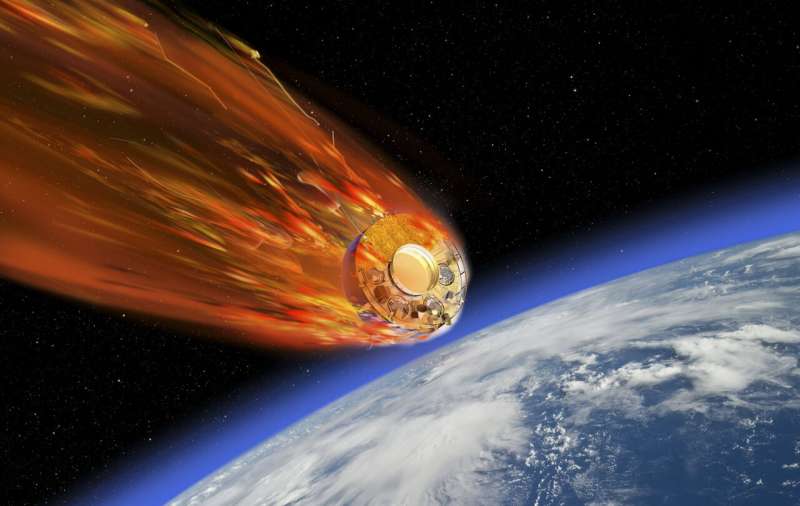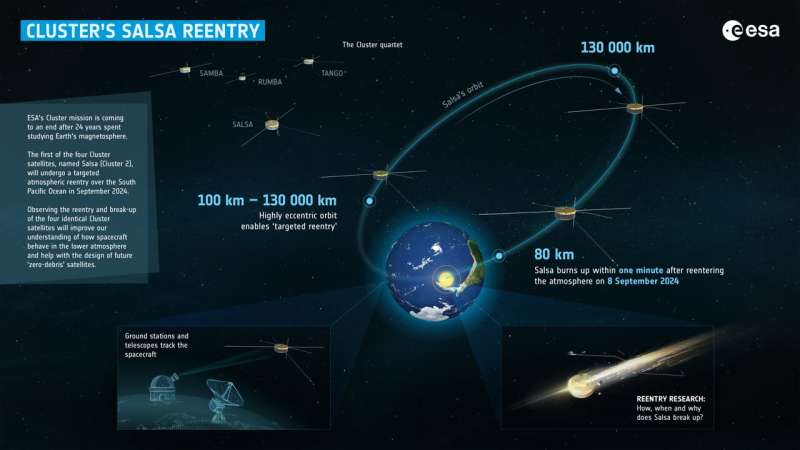This article has been reviewed according to Science X's editorial process and policies. Editors have highlighted the following attributes while ensuring the content's credibility:
fact-checked
trusted source
proofread
Cluster mission set to end with reentry over South Pacific

On 8 September 2024, the first of four satellites that make up ESA's Cluster mission will reenter Earth's atmosphere over the South Pacific Ocean Uninhabited Area.
This marks the end of the historic mission, over 24 years after it was sent into space to measure Earth's magnetic environment. Though the remaining three satellites will also stop making scientific observations, discoveries using existing mission data are expected for years to come.
This "targeted reentry" is the first of its kind. ESA's efforts to ensure a clean end to the Cluster mission go beyond international standards, making the agency a world-leader in sustainable space exploration.
A lifetime monitoring space weather
Launched in 2000, Cluster has spent 24 years studying perhaps the one thing that makes Earth a unique habitable world where life can thrive: its powerful magnetic shield, the magnetosphere.
Like an enormous umbrella, the magnetosphere protects us from most of the driving rain of particles that the sun relentlessly sends in our direction.
But gusts of this solar wind can still push through, sending bursts of energetic particles cascading towards Earth's surface. The most common result is the northern and southern lights (auroras), but more rarely, these particles can cut our power supplies, disrupt radio communications, or damage satellites.
We call the influence of the solar wind on Earth's magnetic environment "space weather." And until Cluster came along, space weather remained something of a mystery.
"For over two decades, Cluster has shown us time and time again how important the magnetosphere is in shielding us from the solar wind," says Cluster Mission Manager Philippe Escoubet. "It has watched the effects of solar storms to help us better understand and forecast space weather."
A zero-debris finale
Cluster was never designed to last this long, nor was it designed for such a safe finale. It was initially launched on a two-year mission to study sun–Earth interactions. Because it was carrying out such impressive and world-changing science, ESA's spacecraft operators kept it going.
But all good things must come to an end, and Cluster's time has finally come. With this targeted reentry, ESA is turning Cluster from a pioneer in space weather monitoring to a pioneer in mitigating space debris—two key elements in the agency's space safety goals.
Without intervention, the four Cluster satellites would have reentered naturally in a less predictable manner, potentially over a more densely populated region. By targeting the satellites' reentries, ESA is taking the opportunity to ensure that Cluster's demise doesn't contribute to the rocketing amount of space junk in orbit around Earth.

Salsa's last dance
Of the four Cluster satellites—nicknamed Rumba (Cluster 1), Salsa (Cluster 2), Samba (Cluster 3) and Tango (Cluster 4)—Salsa will be the first to take the plunge back into Earth's atmosphere. It is targeting a specific region of the South Pacific Ocean that is as far as possible from populated regions.
"Back in January we tweaked Salsa's orbit to make sure that on 8 September it experiences its final steep drop from an altitude of roughly 110 km to 80 km," explains Cluster Operations Manager Bruno Sousa. "This gives us the greatest possible control over where the spacecraft will be captured by the atmosphere and begin to burn up."
Bruno's team is now watching the satellite from a distance. A targeted reentry allows for so much predictability in the reentry time and location that there is no need for further maneuvers.
Despite being confident that no surviving fragments will fall anywhere near land, we still have very little data about how spacecraft behave as they pass through the lower layers of the atmosphere. We would like to know more to predict even better the time and location of satellite reentries and ensure the safety of humans on Earth.
ESA is considering observing Salsa's reentry from an aircraft; this will be confirmed later in August. The four Cluster satellites are identical and so by watching them reenter the atmosphere with slightly different trajectories and in different weather conditions, we would have the unique opportunity to conduct a valuable reentry experiment to study the break-up of satellites.
A brighter future
Cluster's reentry follows those of ESA's Aeolus and ERS-2 Earth observation missions. ESA is setting a precedent for a responsible approach to reducing the ever-increasing problem of space debris and uncontrolled reentries.
With this targeted reentry, ESA is again pioneering a new strategy to reduce its environmental impact by disposing of its missions more safely and sustainably than envisaged at the time of their design.
"By studying how Salsa burns up, which parts might survive, for how long and in what state, we will learn much about how to build 'zero-debris' satellites," explains Tim Flohrer, Head of ESA's Space Debris Office.
"The lessons learned from this activity will help turn targeted reentries into a safe and well-understood option for the disposal of other space missions in similar orbits, such as Smile and Proba-3."
What's next?
Following Salsa's reentry, the three remaining Cluster satellites will enter "caretaker" mode; while they will not be making scientific measurements, operators will be monitoring them to minimize the risk of collision with other satellites or Earth itself.
Bruno's team will adjust the orbit of Rumba (Cluster 1) in August 2024 in preparation for a similar targeted reentry in November 2025. They will then maneuver Samba (Cluster 3) and Tango (Cluster 4) in November 2024, ready for Cluster's final goodbye in August 2026.
At the end of 2025, ESA plans to launch its next mission to tackle Earth's magnetic environment: the Solar wind Magnetosphere Ionosphere Link Explorer, or "Smile" for short. A joint venture with the Chinese Academy of Sciences, Smile will build upon Cluster to reveal even more about the complex and intriguing magnetic environment surrounding planet Earth.
Provided by European Space Agency





















